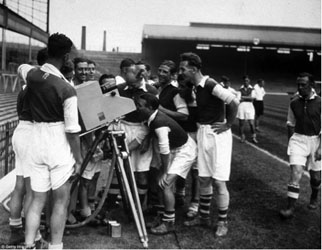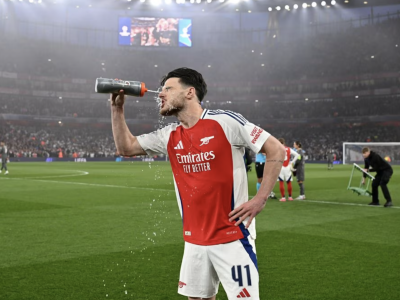If like me, you spend your Thursday evenings watching the BBC4 re-runs of Top of the Pops from thirty five years ago, you’ll have noticed that it’s just reached the stage where The Jam have crashed into the charts at number one with ‘Going Underground’. The band’s lone crusade of a Mod revival three years prior had by now snowballed to the point that it had started to engulf the UK charts. Back in late 1979/early 1980, the influence of the mid-sixties on the pop charts seemed to be everywhere.
Along with The Who adapting ‘Quadophenia’ into a feature film there was also the emergence of a batch of Paul Weller clones like The Chords, Secret Affair or the Merton Parkas. There was also Dexys Midnight Runners hailing Northern Soul icon Geno Washington; Annie Lennox’s pre-Eurythmics band The Tourists covering Dusty Springfield; The Ramones reworking ‘Baby I Love You’ by The Ronettes, 2-Tone bands like The Specials, The Beat, Selector and Madness taking their cue from Jamaican Bluebeat stars like Prince Buster and a re-release of mod anthem ‘Green Onions’ by Booker T & the MGs, danced here by Legs & Co wearing stereotypical 1960s outfits.
Viewed through 2015 eyes, the whole fad looks an odd one being that it was eulogizing a period which was little more than a decade and a half earlier. Part of the explanation for this mod revival had been that the first wave of the fad during the 1960s had signalled a time when the wage packets of British youth had unprecedented purchasing power, an image that was no doubt seductive to late 70s/early 80s kids as youth unemployment skyrocketed (the same TOTP episode of Going Undergoing reaching number one also included the debut appearance of UB40). However, roughly similar comparisons could be drawn between the prospects of today’s youth and those leaving school in the late 90s/early 00s and yet (leaving issues of musical quality aside) no comparable Craig David/Artful Dodger Speed Garage-type revival seems to be gripping today’s music charts.
The crucial difference of course is that in 1979/80, the absence of technology popularized in subsequent years had made the culture of 1964 feel so remote by 1980 in a way that the millennium period doesn’t particularly feel so today, even by those who were very young back in 1999/2000. The reason being that much of the archive of televisual output capturing the world of popular culture from the mid-1960s no longer exists. As an example, due to the BBC’s policy of wiping their tapes for reuse, only eight out of twenty episodes of the original series of The Likely Lads still exist. Under Equity rules, those that did survive could only be repeated a limited number of times on a limited number of channels by 1980. In comparison, its 1990s equivalent – Men Behaving Badly – is owned by many individuals on VHS and DVD, as well as uploaded on YouTube and perpetually repeated on multi-channel TV. The fact that the produce of this period is still within easy reach for us partly explains why no great yearning to revive the culture of the late 1990s really exists in 2015.
When it comes to wiping, the world of pop music was probably the biggest loser, as most of the episodes covering the first dozen years of Top of the Pops were lost altogether. Though footage of Peter Marinello’s appearance judging a dancing competition in 1970 still exists, that of the Arsenal First Team Squad the following year singing ‘Good Old Arsenal’ on TOTP five days after completing the double is wiped forever – a fate which also befell all but nine other episodes from that calendar year (and sadly, all but three of those remaining were presented by the odious figure of Jimmy Savile). The football world in contrast was far luckier in that Television executives from that period recognized the game’s social significance and that most episodes of Match of the Day, or ITV’s regional equivalents such as The Big Match, still remain in the archives. However, what strikes you all these years later is how so few games from this period were even recorded in the first place.
Those of you who follow me via Twitter will know that I like to make good use of the #throwbackthursday and #flashbackfriday hashtags to upload links of past fixtures involving Arsenal against their upcoming opponents that following weekend via video sharing sites such as YouTube, Daily Motion, ITN Source, British Pathe and Movietone News. My #throwbackthursday content tends to be the deep catalogue of the pre-premiership era, where my #flashbackfriday content is the recent catalogue of the post-premiership years. It’s astonishing how, despite covering a period of just twenty three years, the amount of post-premiership footage now seems to outweigh that of existing footage for the other one hundred and six years of Arsenal’s history that precedes it.
Former Arsenal boss Tom Whittaker in his autobiography, written just before his death in 1956, prophesized that: ‘sooner or later…League clubs will have to allow TV into their games. It’s inescapable, like the Radio, the telephone, the jet engine and the smell outside a pickle factory…the day will come, perhaps soon when a Soccer match will be televised every Saturday, the whole ninety minutes and those unable to see it, either live or in their homes, will be able to sit in the comfort of a cinema seat and watch the game on the “New Wide Screen” in three dimensions’. Despite this however, for much of the post-war era Football dealt with television at arm’s length and not without good reason.
Not only had the medium led to the closure of several of the nation’s music halls and turned many a cinema into a bingo hall, but also popular pre-war sports such as Greyhound Racing and Speedway took an enormous hit with famous pre-war venues such as the West Ham Stadium (once the world’s biggest sports arena) bulldozed and turned into a housing estate. Football too saw a sharp post-war decline in attendance figures, from a peak aggregate of seventy million across all four professional divisions in 1950 to just twenty million by the late 1960s, with many pointing the accusing finger at television, leading to this on-air defence from Brian Moore and Jimmy Hill on LWT’s The Big Match in 1973. In the end, the ‘Anti-TV Brigade’ that Jimmy Hill refers to lost their argument.
The record post-war low for football attendances was reached during the 1985/86 season, amidst a TV blackout that resulted from the breakdown of negotiations between the Football League and the BBC and ITV. As seen here from this retrospective fifty minute programme, the first half of that season is covered in just seven minutes. Within two years, every single top flight fixture bar none would be captured by the cameras. Today, with the Football League Show scheduled back to back with Match of the Day on BBC1’s Saturday night schedule, every game in all top four divisions of professional football in England are covered by the cameras. Even non-league semi-pro sides like Bromley and Canvey Island have highlights of their games shown via their own YouTube channels. And yet, unfathomably, football attendances across all the divisions have increased on what they were a quarter of a century ago.
It’s difficult to imagine that if something noteworthy happens at all on a Football pitch in 2015, that there wouldn’t be video footage of it available somewhere in some form. And yet, archive video footage of noteworthy Football matches from not that far back in time do not exist in any form whatsoever. For example, when Spartak Moscow played Arsenal off the park at Highbury back in 1982 and even received a standing ovation from the Arsenal crowd, the only footage on YouTube revolves around a few stills played over music. From the double season of 1970/71 some form of footage exists for at least twenty four of the sixty four fixtures that Arsenal played that season, however nothing whatsoever exists for their biggest win that season – a 6-2 home victory over West Bromwich Albion.
Nothing also exists of Arsenal’s last win at Anfield before May 1989 – a 3-1 win in November 1974, with goals from Alan Ball and Liam Brady. And for Arsenal’s 1-0 home win against title challenging West Ham United, which I attended as a seven year old in March 1986, I’ve got little more than my own memory to recall Tony Woodcock’s late winner and Alvin Martin’s last minute sending off. The Big Match footage of this game against Everton (@0.40) shows that Arsenal were videoing their games privately for their own dissection as early as 1970. However, part of the reason why television companies wiped their archives during the 1960s and early 70s is due to the fact that a video tape around this period had cost the same price as buying the fashionable new Mini car, so it’s highly unlikely that the club would have retained much in the way of footage of games from around this time, however it’s worth asking what footage of its own history can the club unearth.
By the 1990s, with the popularization of the VCR and the home video market, as well as the growth of multi-channel TV, the TV companies began to realise the worth of their extensive back catalogue of programmes, leading to the BFI introducing the Missing Believe Wiped initiative ‘Treasure Hunt’ in order to hunt down missing archive material. It would be interesting to see if Arsenal Football Club could carry out something in a similar vein and make such footage available to Arsenal members via its Arsenal Player service on the club’s website (the back catalogue of games available on which only seems to go back as far as 2005).
On the issue of Arsenal’s annual membership fee for the right to buy match day tickets, Matthew Bazell, in his lament on the modern game – ‘Theatre of Silence: The Lost Soul of Football’ – sarcastically retorted: ‘next time I go to a restaurant maybe I should pay £26 to look at the menu?’. The Arsenal Player service is one of the few tangible things you actually get for the price of the membership fee alone.
Perhaps to compensate for this, the club could give its fans something of a treat for its membership fee by searching its own archives, as well as coming to an agreement with the various television companies and copyright holders of newsreel footage by attempting to make all known existing footage of previous Arsenal games available to their many worldwide members via Arsenal Player. Arsenal’s history is, after all, one of the club’s assets that very few other English club ‘brands’ can hope to match.
Robert Exley is the author of Modern Life Is Rubbish: How Feral Capitalism Ruined British Culture







